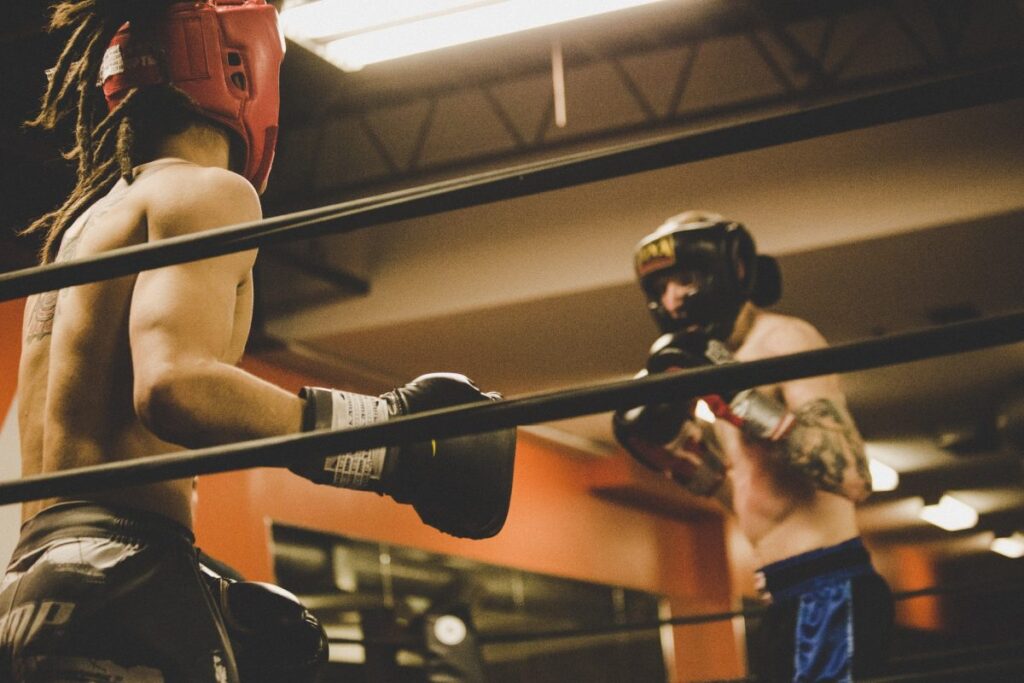
Boxing is an effective sport for maintaining mental and physical harmony and health.
However, for beginners to start boxing, it is essential to learn basic techniques and build physical strength.
This article provides a guide for beginners to effectively acquire boxing techniques.
By learning safe and efficient training methods, you can maximize the enjoyment of boxing and its health benefits.
Now, let’s take a closer look at the basics of boxing, specific training menus, and practical advice.
目次
Setting up a proper practice menu is very important when learning boxing.
This sport requires not just strength and speed, but also technique, strategy, and endurance, so an effective training menu is the foundation for improving your technique.
A boxing practice menu needs a structure that aims to learn a variety of techniques in a balanced manner.
For beginners to make solid progress in the sport, a wide range of skills must be incorporated, from basic punch-throwing to defensive techniques and footwork.
Boxing basics that beginners should know
Learning the basics of boxing is essential to practicing safely and effectively.
Correctly understanding and practicing basic posture and how to throw a punch is the foundation of all techniques.
For example, hitting an accurate jab is an important skill for getting a sense of distance, and it is also directly connected to the basics of defense and counter attacks.
Beginners are encouraged to start by learning the correct form for each punch and gradually move up to compound movements.
The importance of frequency and persistence of practice
Continuous practice is essential to improving your boxing skills.
Generally, it is recommended to practice 3 to 5 times per week for 60 to 90 minutes per session.
The training content is wide-ranging and includes everything from technical skills training to conditioning and sparring to develop strategic thinking.
Continuous training not only increases physical endurance, but also develops reaction speed and mental alertness.
It’s also important to measure your progress and adjust your practice menu as needed through regular feedback and self-evaluation.
By properly constructing a boxing practice menu and faithfully following the basic principles, even beginners can efficiently improve their technique.
By deepening your overall understanding of the sport, you will be able to live a safer and more enjoyable boxing life.

How to warm up and stretch
Effective warm-up and stretching in boxing is an essential part of preventing injury and improving performance.
This section details how to properly prepare your body before starting a boxing training session.
Warming up builds the foundation for better performance by increasing blood flow and activating muscles.
Stretching, on the other hand, improves the accuracy and speed of your technique by increasing the flexibility of your muscles and increasing your range of motion.
effective warm-up routine
Warming up is a very important first step in training.
To warm up for boxing, it is recommended to start with some light aerobic exercise that uses the entire body.
For example, jumping jacks, shadow boxing, and short distance sprints are effective.
These activities increase your heart rate and help increase your body temperature.
Next, you can prepare for a serious workout by performing dynamic stretches that target specific muscle groups.
Dynamic stretching involves exercises that involve large movements of the arms and legs, which can increase the range of motion of your joints.
Types of stretches suitable for boxing
Boxing-specific stretches should specifically focus on the arm, back, and leg muscles.
This includes stretches that encourage rotation around the shoulders and movements that lengthen the hamstrings, calves, and back muscles.
It is important to incorporate both dynamic and static stretching in a well-balanced manner.
By mainly performing dynamic stretching before training and incorporating static stretching after training, you will help your muscles recover and prepare your body for the next training session.
Static stretching involves holding a certain pose for a long time to slowly stretch your muscles and improve flexibility.
Especially in boxing, it is important to release muscle tension from striking movements.
Examples of static stretches include arm stretches and quad stretches.
An arm stretch involves stretching one arm over your head and to the opposite side, stretching the muscles in your shoulder and upper arm.
The quad stretch increases flexibility in your lower body by grabbing the ankle of one foot, bending your knee and stretching the front of your thigh.
These stretches specifically target muscle groups commonly used in boxing, which can improve performance and reduce the risk of injury.
Mental focus is also important when training for boxing or warming up before a fight.
Proper warm-up and stretching will help prepare your mind and body for battle.
In order to increase relaxation and concentration, it is also effective to incorporate breathing-conscious stretching and meditative elements.
In this way, by combining warm-up and stretching, you can bring out the best performance in boxing and minimize the risk of injury.

Learning basic techniques and drills
Mastering the basic techniques of boxing is the first step to becoming an effective fighter.
In this section, we will explain in detail how to throw the four basic boxing punches: the jab, straight, hook, and uppercut.
These punches play a central role in boxing tactics and are important not only for damaging the opponent but also for creating opportunities for defense and counterattacks.
How to hit a jab and straight
The jab is one of the most basic and important punches in boxing.
This technique measures your distance to your opponent and serves as a starting point for your attack.
When launching a jab, quickly extend your lead hand forward and aim at your opponent’s face or body.
The jab has the effect of breaking down the opponent’s defense because it is easy to break through the defense.
On the other hand, a straight is delivered from the rear hand and is more powerful than a jab.
When hitting a straight punch, you can use the rotation of your hips to accelerate the punch and cause more damage.
Basics of hooks and uppercuts
A hook is a side attack, a powerful punch that hits the side of the opponent’s guard.
To hit a hook, bend your arm, raise your elbow slightly, and use hip and shoulder rotation to deliver the punch.
A precise hook can hit the opponent’s jaw or temple, resulting in a KO.
An uppercut is a punch launched from below the opponent upwards, and is mainly effective at close range.
When throwing this punch, bend your knees, lean your upper body slightly forward, and deliver the punch with explosive force.
Maintaining proper form is extremely important when practicing these basic punches. By practicing these techniques repeatedly through drills, your speed and accuracy will naturally improve.
Also, by combining these punches, you can create more complex and effective combinations, allowing you to develop a variety of tactics in the ring.

Defense technique training
Defense techniques in boxing are just as important as attacks.
A boxer with good defensive skills can effectively block the opponent’s attacks while creating opportunities for counter attacks.
This section details basic guard stances, evasive movement techniques, and counter strikes.
By mastering these techniques, you will be able to increase your chances of survival in the ring and establish an advantage in the match.
Guard basics and movement practice
Basic guarding in boxing is very important to protect your face and upper body.
The correct guard position is to keep your hands at face level and your elbows close to your sides to protect your abdomen.
From this position, the boxer can effectively block direct attacks such as jabs and straights.
Also, practicing maintaining your guard while moving is essential to react quickly to your opponent’s attacks and move to a safe position.
Combining footwork and guard movements can improve your positioning while defending.
How to avoid and counter
Avoidance movements include ducking, weaving, and slipping.
These techniques are ways to dodge your opponent’s punches while waiting for a counter opportunity.
For example, a slip is a movement in which you avoid an opponent’s punch by moving your head from side to side, which can throw your opponent off balance.
Ducking is the act of bending your knees and getting low to avoid headshots.
A counter attack is a technique that allows you to counterattack instantly after evading an opponent’s attack.
In order to counter effectively, it is important to time the punch immediately after the evasive action.
For example, by immediately following a slip motion with a jab or straight, you can take advantage of the moment when your opponent is at their weakest to defend.
This smooth coordination of defense and offense is essential to success in boxing.
By practicing and mastering these defense techniques, boxers can fight safely in the ring for longer.
These skills also allow you to put psychological pressure on your opponent, which can be used to swing the flow of the match to your advantage.

Conditioning and strength exercises
Boxing is a sport that requires extremely high levels of physical strength, which requires specialized conditioning and training to improve physical strength.
This section details the exercises and effective high-intensity interval training (HIIT) methods that can help boxers build the strength they need.
The purpose of these trainings is to simultaneously increase stamina and explosive power in order to achieve sustained high performance in matches.
Building the physical strength necessary for boxers
Boxing requires sustained energy and instant power.
To achieve this, it is important to balance aerobic and anaerobic exercise.
Aerobic exercise includes running and cycling, which improve cardiorespiratory fitness and help maintain consistent performance throughout the match.
Anaerobic exercise, on the other hand, includes sprinting and weight training, which are effective for increasing muscle strength and explosive power.
By combining these training sessions, boxers can develop both the stamina for long matches and the explosive power to get through a pinch.
High-intensity interval training (HIIT)
High-intensity interval training (HIIT) is a training method that allows you to get maximum results in a short amount of time.
HIIT pushes your body to its limits by alternating periods of very high-intensity exercise with low-intensity recovery periods.
For example, do several sets of 30 seconds of sprinting, followed by 60 seconds of recovery with a walk.
This training not only accelerates the body’s metabolism and increases the fat burning effect, but also contributes to improving cardiopulmonary function.
HIIT is especially useful for boxers to build up the strength and stamina for intense rounds of competition in a short amount of time.
These conditioning exercises form the basis for boxers to perform at their best in the ring.
By doing these trainings regularly, you will be able to improve your physical strength as well as your technical skills.
There are many unpredictable developments in a boxing match, and it is important to have both physical and mental strength to deal with them.

Preparation and mindset for sparring
Sparring is an important training method to practically hone boxing techniques.
By exchanging techniques directly with your opponent, you can develop your reaction speed and tactical thinking in a way similar to actual combat.
This section details sparring preparation, basic rules and etiquette, as well as practical sparring tips.
With proper preparation and mindset, sparring can effectively improve your technique and confidence.
Basic rules and etiquette of sparring
Safety should be your top priority when sparring, and understanding proper rules and etiquette is essential to that end.
Sparring is not a competition, but a part of training, so the focus should be on practicing technique and avoiding heavy blows.
In addition, in order to build a relationship of trust with your opponent, you are required to use the correct equipment and behave with mutual respect.
Maintaining a strong guard and throwing punches with controlled force creates a healthy sparring experience where both players learn from each other.
Practical sparring tips
There are many tips for successful practical sparring.
First of all, it is important to be relaxed in the ring. When you’re nervous, your movements tend to become stiffer and your reaction speed tends to be slower, so it’s important to regulate your breathing and calm your mind.
Also, the key to sparring is to carefully observe your opponent’s movements and judge the timing of your punches.
You can create counter chances by focusing not only on attack but also on defense and effectively avoiding the opponent’s attacks.
Furthermore, by mastering short combinations, you can maintain a safe position while putting pressure on your opponent.
Sparring is an essential part of improving your boxing skills, and by following these basic rules and tips, you will hone not only your technique, but also your strategic thinking and reaction speed, developing true fighting skills.

Meal and nutrition management
In high-intensity sports like boxing, proper diet and nutritional management greatly affect performance.
A nutrient-dense, balanced diet is essential for maximizing the effectiveness of your training, promoting recovery, and keeping you in peak condition for competition.
This section details the types of meals recommended for boxers and how to nourish them before and after training.
Recommended meals for boxers
The ideal diet for a boxer consists of high-quality protein, complex carbohydrates, and healthy fats.
Protein is needed for muscle repair and growth, and chicken breast, fish, legumes, and low-fat dairy products are good options.
Complex carbohydrates provide long-term energy and can be obtained from whole grains, fruits, and vegetables.
Healthy fats are not only a source of energy, but can also help reduce inflammation in the body, with olive oil, avocado, and nuts recommended.
By combining these foods appropriately, you can balance your body and increase the effectiveness of your training.
Nutrition before and after training
Pre-exercise nutrition should be aimed at maximizing performance and focus on providing the energy needed for practice.
It is recommended that you eat a lightly digested meal, mainly consisting of carbohydrates, approximately 2-3 hours before training.
For example, bananas, pancakes made with flour, yogurt, etc. are suitable. This stabilizes your blood sugar levels and gives you sustained energy during your practice.
On the other hand, post-exercise nutrition should focus on restoring depleted energy and repairing muscles.
Ideally, a meal containing protein and carbohydrates should be consumed within 30 minutes, such as a smoothie or a sandwich containing lean protein.
By following these dietary and nutritional guidelines, boxers can increase the effectiveness of their training and prepare themselves for peak performance in competition.
A proper diet is the foundation that supports the physical strength and endurance that boxers require.

Creating and evaluating practice plans
A strategic and scientifically based training plan is essential to success in boxing.
Planned training allows you to see your progress toward your goals and make adjustments as needed.
This section provides a detailed explanation of how to create an effective training plan and the importance of evaluating and adjusting your training progress.
This prepares the boxer for continued growth and peak performance.
How to create an effective training plan
In order to create an effective training plan, you first need to be clear about your current fitness level and specific goals.
Depending on a boxer’s goals (for example, preparing for a specific fight, managing weight, improving technique, etc.), the content, frequency, and intensity of the exercises will vary.
Your plan should combine short-term and long-term goals and consider how each goal contributes to the overall plan.
In addition, it is important to clearly state the timing of technical practice, physical strength building, recovery period, and evaluation in the training plan, and to maintain a balance as a whole.
Importance of practice progress and adjustments
Regularly evaluating your practice progress and making adjustments to your plan is essential to maximizing the effectiveness of your training.
Progress evaluation includes performance logging, physical measurements (e.g., weight, muscle mass, heart rate), and technical progress evaluation.
Based on this data, you can adjust the intensity and focus of your training as needed.
For example, if you learn a certain skill faster than expected, you can make adjustments such as focusing on other skills.
Avoiding overtraining and allowing for adequate recovery time are also important in your training plan.
Scientifically managing training regimens in this way allows boxers to develop their skills efficiently, resulting in long-term sustainable growth and success.



